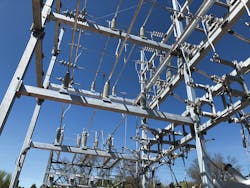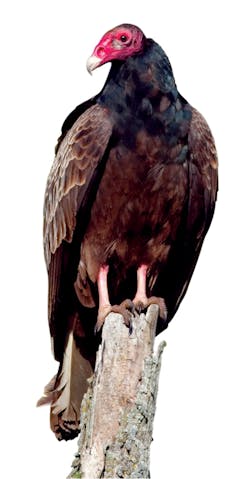Lingle Substation Upgrades Mitigate Wildlife Issues
Western Area Power Administration has completed at the Lingle Substation structural replacements and upgrades that were prompted by the presence of turkey vultures. The work at the substation in Goshen County, Wyoming, began in January and continued through May.
The substation was facing a potential threat to its reliability from turkey vultures. The upgrades have benefited both customers and the birds.
"There had been several extended station outages because of turkey vultures breaking the minimum approach distance and causing faults on the main bus," said Brian Bucks, electrical engineer. "When faults occurred because of the turkey vultures, the old post insulators were usually damaged. These old insulators are a challenge to find replacements for."
"We had several customer outages in the Lingle area and to the west," said William Weber, field maintenance manager. "These were all caused by wildlife getting into places they should not have been."
The main work at Lingle consisted of moving the 34.5-kV bus and switches so that they would be farther apart, preventing the outages turkey vultures and other critters could cause. Doing this also presented an opportunity to make other improvements.
"We wanted to replace all of the oil breakers in the sub with SF6 gas breakers," Weber said. "This substation sits very close to the Platte River as well as other small bodies of water."
Sulfur hexafluoride (SF6) circuit breakers use SF6 gas to cool and quench the arc on opening a circuit. Initially developed in the 1950s, SF6 breakers are used in electrical grids at transmission voltages up to 800 kV as generator circuit breakers and in distribution systems at voltages up to 35 kV. Advantages over other media include lower noise, no emission of hot gases, and relatively low maintenance needs.
Oil-filled breakers contain mineral oil which, if discharged during a failure, will pose a fire hazard. Oil is also toxic to water systems and leakages must be carefully contained. SF6 breakers avoid these potential issues.
"We were also able to remove oil-filled equipment from a Spill Prevention, Control, and Countermeasure (SPCC) site," said Bucks.
Additionally, the insulators were replaced, which would mitigate outages caused by wildlife and thereby improve reliability. The existing 115-kV brown post insulators were nearing the end of their lives.
"We replaced those with new Epoxilator station post insulators on May 14," said Weber. "Some of the brown glass had cracks and may well have separated soon. This was a good chance to replace them before they caused any further problems down the line."
Lingle Substation is located near a decommissioned Bureau of Reclamation power plant that dates back to the 1920s and was originally tied to that facility. As a result, the original foundations had degraded and a number of the structures — built through the 1930s and 1940s — were reworked and replaced as part of the upgrades. This includes the entire structure for the 34.5-kV breakers.
"It was a big job and it might seem silly that all of this came from a problem with turkey vultures, but nothing is silly when it comes to reliability for the customers who depend on this substation," said Weber.

